Two of the most frequently asked question groups we get are on installing wheel lights and installing roof lights. Maybe the reason it comes up so often is that both may require some flexibility and adaptation depending on the specific model (and even year) of golf cart and/or of other aftermarket products already installed on the golf cart. The exact same method may not always work. But with a little understanding of a few common techniques, any application of lights can be installed on any cart. And with a little extra know how, an installation can be made to look stock or even almost invisible until the lights are activated.
For this post, we’re going to focus on an installation of roof lights and walk through a typical install using a late model EZGO TXT as an example because it presents a couple challenges that frustrate even installers that don’t know some of the tricks of the trade. The challenges and techniques we’ll use are just a combo of multiple ways to do it, and specific to the popular type of roof on this particular cart, so we’ll try to mention some of the other methods you might need to employ on other carts with other roofs. But we can’t possibly address every cart, roof, product or technique, so hopefully this will give some helpful insight(s), and of course, we’re always happy to talk to you about any project.
As stated in our FAQ on installing roof lights, although not imperative, our strong preference is for roof light installations where the lights are as hidden as possible when off, but still clear and bright when switched on. So that’s what we’ll do with the TXT for extra credit.
There are multiple ways to route roof lights. The wiring can be run in a number of ways and the lights can be made to chase in complete circuits or mirrored bi-lateral runs in parallel down the length of the cart for example. For this install, we are going to run left and right strips that start at the center front of the cart, travel down each side and meet in the back, so that the lights flow like waves parting around a boat as the cart travels. We don’t recommend running out lights across the entire front like we are going to do here without using proper diffusers. Flashing lights just above eye level facing a driver could impair a driver’s view, and our lights are pretty much the brightest available, many times brighter than most. We will be installing extra diffusion up front so you can still see the lights but a driver’s view won’t be impaired by them. If not adding diffusion covering, or not sure, simply start the lights at the front corners and work back from there.
For this install we will run the wires from the controller up the left and right front roof support tubes (the ones the windshield attaches to) to hide the wires between the lights and the controller. The controller will be installed behind the dash, and power to the controller will be run from an open slot on our fuse block which is fed by a voltage converter that steps the carts 48v down to 12v for use with accessories.
Fuse Block and 48v to 12v DC Voltage Converter
Given our stated preference for installs that completely “hide” the lights, there are a couple of common ways we do that. The first is the more common. Many golf cart roofs have tracks/channels around the perimeter for various purposes light mounting accessories and/or enclosures. Some have single channels, some two channels and some even have three channels. Sometimes the open end of the channels face inward and sometimes the open part faces downward. When these tracks is open and unobstructed, they can be useful for holding LED roof lights. We have several different products (most often made of silicone) that come in rolls of various length as needed and that are shaped to fit the different types of channels, holding LEDs within and allowing for concealment, bending corners and professional appearance installations. The LED strips run inside these silicone diffusers. The diffusers focus the light in the direction of the opening (either inward or down as needed) and allow it to shine through that side when the lights are turned on. When the lights are off, all that is seen is the tube filling the channel, which basically looks like part of the roof and channel. We also have segmented lights in hard plastic and metal channels for various uses but they are rarely needed for a roof unless you intentionally don’t want to go all the way around the four corners.
The roof on the TXT we are installing on today has a neat little smallish channel of it’s own all the way around the perimeter that has an opening facing inward (which could be ideal). But the channel (and it’s opening) are too small to hold a typical LED diffuser tube like we use on many other cart roofs with larger channels, but plenty large enough to hold a standard size (10mm PCB) LED strip inside it if inserted through the opening at an angle and pressed into place against the back (outer) wall of the channel. But a couple of challenges are immediately apparent:
Challenge #1:
Challenge #2:
The first challenge is that the roof is mounted to the roof supports by two bolts at the front and two more bolts on each side attach the roof to the rear roof supports. The bolts pass directly through the middle of the channel in those six spots obstructing the path for our LEDs.
The second challenge is that LEDs when placed in the channel directly without a diffuser tube are still too visible for our picky liking when not in use. While most people would probably never notice them when off, those little LED chips would be peeking out at us… and that won’t do.
Challenges to Overcome
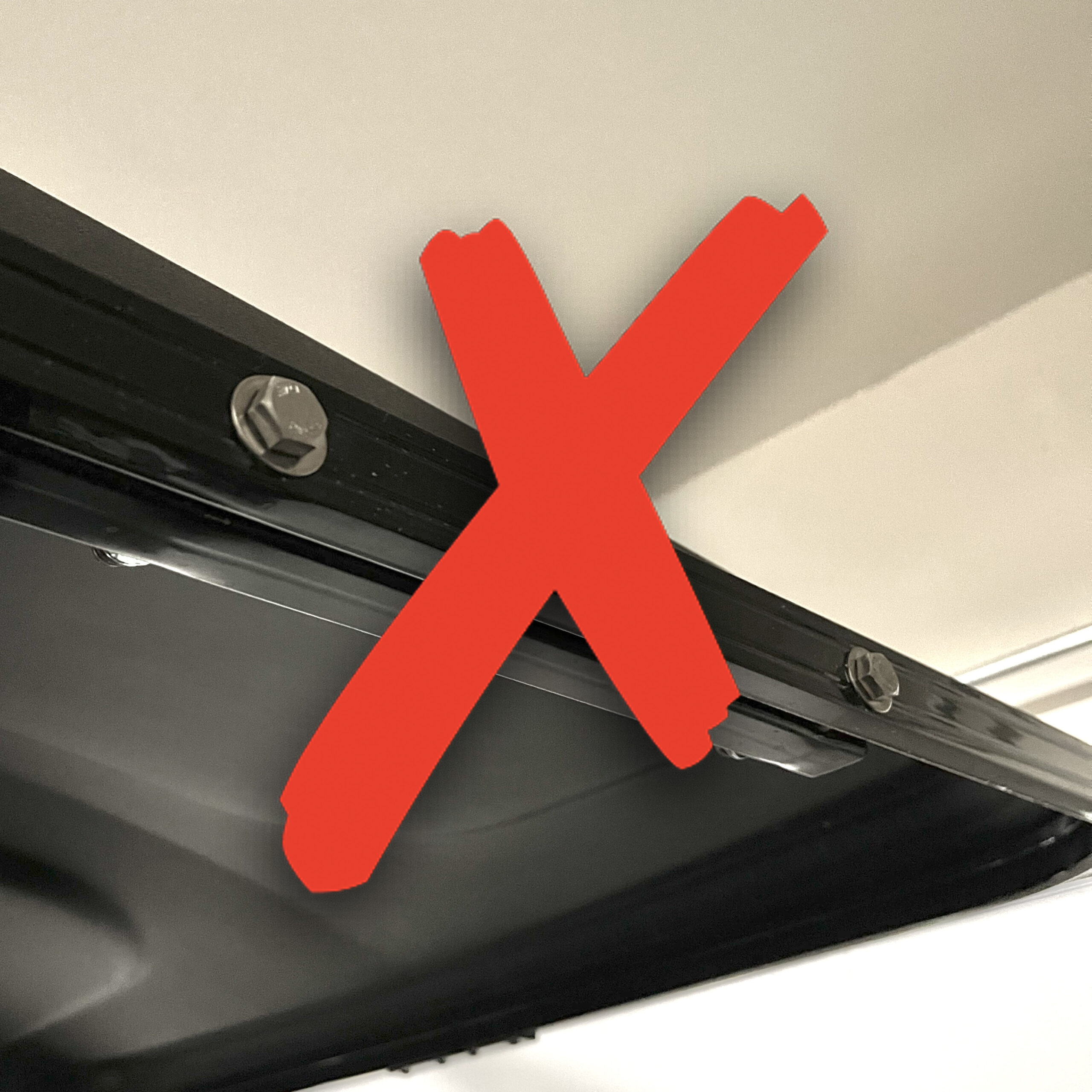

Solution #1: We’ve seen folks just run strips in the space between the front bolts and first side bolt (about 2/3 of the cart) and call it a day. We’ve seen other have the strip exit the channel and run un-elegantly and visibly around the support and bolts and then dive back into the channel to continue on the journey around the cart. We’ve even seen some cut a strip, solder on jumper wires to run around the bolts and start more strip on the other side (a serious hassle).
But our recommended solution is a bit more elegant, and honestly pretty easy to do. We prefer to simply move the bolts out of the way. And here is how we are going to do it and how you can do it.
Before starting work on modifying how are TXT roof attaches, we make sure we have some “tee” bolts (see example below) that around 1/2″ shorter than the original front and side roof attachment bolts.
"Tee" Bolt Example
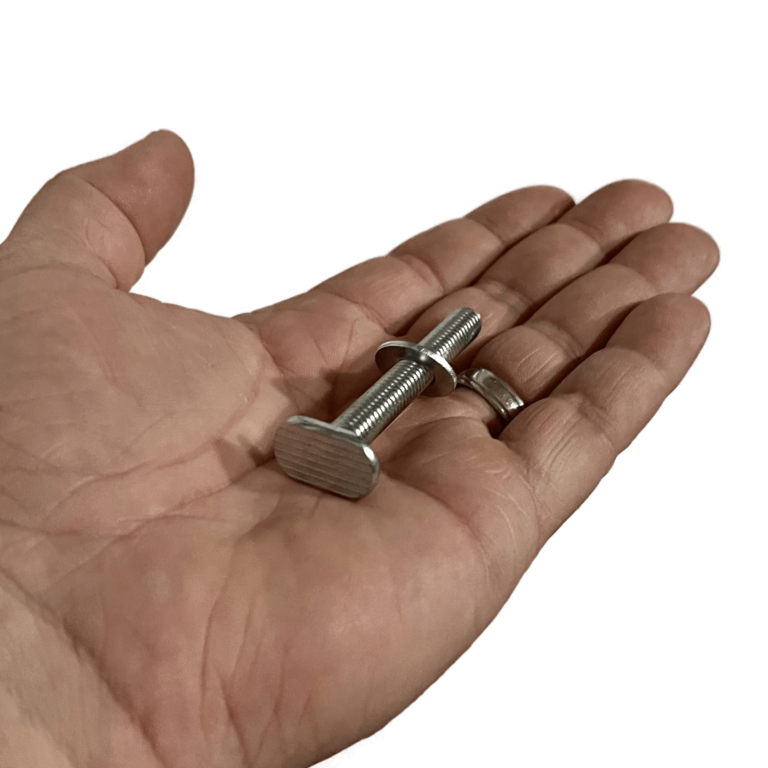
The front bolts are usually longer and pass through metal stand off tubes and washers. The side bolts are usually shorter and pass usually pass through washers and small spacers that create a gap between the roof support and the roof track. It’s important to note and remember how the front and side bolts and offsets assemble (or take pictures if necessary), particularly if you haven’t made this particular modification before.
After confirming we have the right size and quantity of “tee” bolts (and matching washers and nuts) we remove the (2) old front and the (4) side roof bolts and set aside.
Next, off comes the the roof and we place it underside facing up on a work surface for ease of installing the light strips.
For our TXT installation example, as noted, we run the left and right wires from the controller up the left and right roof supports. (We of course like hidden so prefer internally.)
We remove the windshield and loosen the front roof supports so we can drill an entry hole in the left and right vertical support tubes in a spot where the wires can pass through the cart wall (another drilled hole) and into the square tube, up the tube to an exit hole somewhere at the top near where the LED strips will connect. We first pull string through the tube with a wire fishing tool, then use the string to pull the wire through. Our Signature LED lights all use waterproof barrel connectors that just twist to connect. We drill the holes just big enough to pass the barrels through. And even though we smooth any rough edges, we use rubber grommets to protect the wires from rubbing against any edge but also to neaten up the appearance and fill most of holes (see pic below).
Pulled Wire and Rubber Finish Grommet

When finished with running the wires inside the square tubing and back out, we reinstall the front roof supports and windshield taking care to avoid the cables now in the tube when re-installing the attachment bolts and windshield bolts.
With the roof off and lying down side up, we install the LED strips in the channel so the LED chips are centered and facing out. We recommend using a pencil with an eraser end to press the LED strips against the back of the inside of the metal channel to adhere them. The adhesive on our strips is very strong. Always take care to adhere the strips where you want them because the adhesive is so strong they sometimes can’t be removed without breaking the strips. Take your time and keep them reasonable centered. We start where the LED connection wires will exit the channel to attach to the wires running to the module. In our case we are starting at the front center with the strips butting up against each other, traveling back along each side and eventually meeting back center. (We simply trim any extra off each strip at a cut-point leaving enough to meet or overlap just slightly at back center and apply a little silicone over the cut end to keep things completely waterproof).
Once the LEDs are in place, the shoe bolts are inserted through one of the existing inward facing holes from the original bolts. By angling the shoe and twisting, it slides in.
Inserting and Sliding "Tee" Bolts in Channel
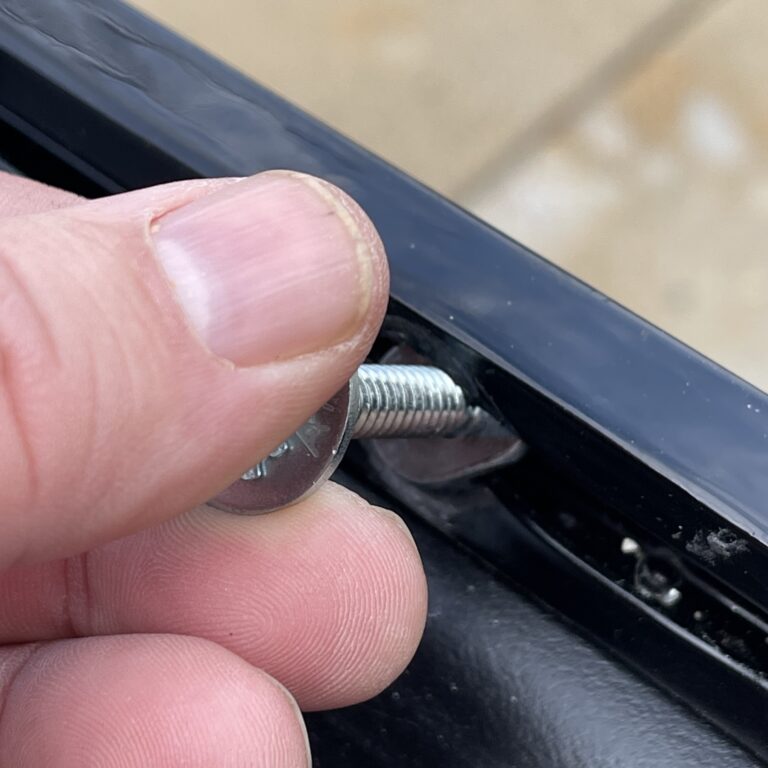
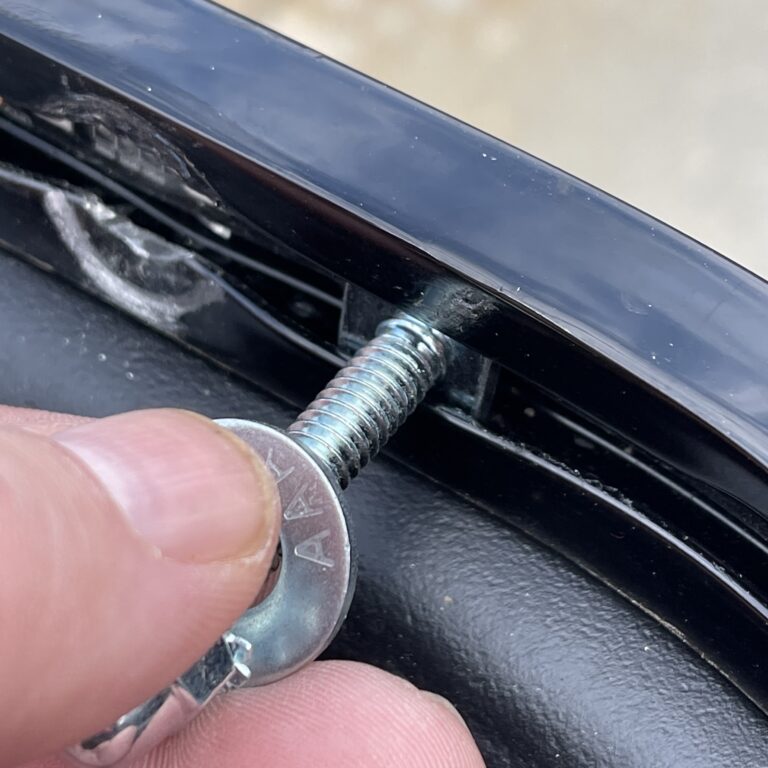
When the bolts are perpendicular, the heads won’t fit through the holes and the bolts can be slid to any position in the track once inserted. The heads are flat and there is plenty of room in from of the LED strips for them to slide around. When tightened, they will actually be pulled up against the rail in the direction away from the LED strips and cannot make contact with them once secured. We have found that the front holes are often bent inward from the standoffs and pressure and are often easier to insert the shoe bolts into. If none of the holes are allowing entry, we make one ever so slightly bigger and insert all the bolts there and then slide them around the track to their final positions.
We like to stay pretty close to the original holes as guides for placement. We don’t use lock nuts because we don’t want the shoes to turn while we’re tightening. We substitute regular nuts and lock washers instead.
Once we have all six shoe bolts installed, we place the roof on top of the cart with the new bolts in their approximate positions. Then we install the new bolts through any washers, spacers and/or standoffs as before and through the front and rear roof supports securing with regular nuts, washers and lock washers using old positions as a guide.
Once the bolts are all secured, the strips can be twist connected to the controller wires. We test the lights to make sure they weren’t damaged while re-installing the bolts and roof and before cleaning up the wires and moving on to solution #2, our final finesse step.
Testing the Golf Cart Roof LED Lights
Having verified that the lights are still cleanly centered in the track and working fine and that the bolts and roof are tight and secure, we push any excess wire back into the roof supports and secure the remaining wire outside the supports to the crossbar with zip ties so it is snug, hidden and neat. And now that the roof bolts only secure to the inside of the channel and don’t go all the way through, we’re left with some holes on the outside of the channel so we cover them up with some plastic caps.
Tidying Up
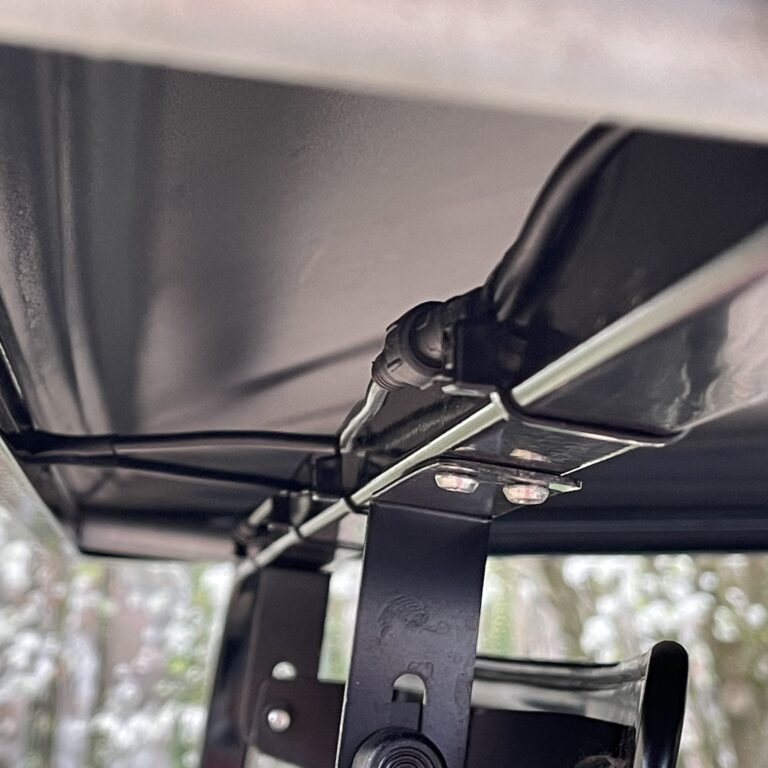

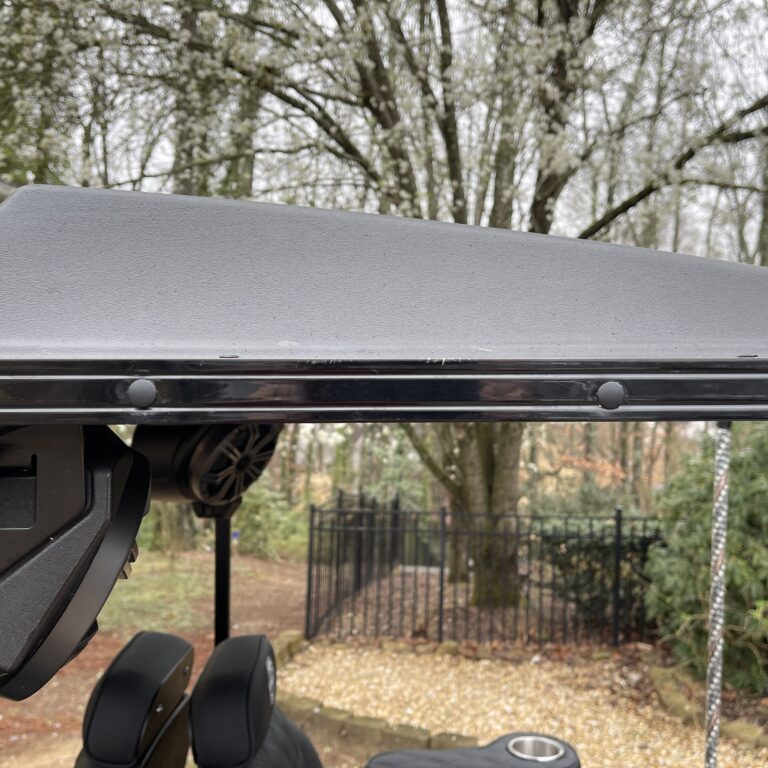
Solution #2: The strips are now routed in the channel all around the roof from front to back. But the LEDs… although recessed in the back of a nearly closed channel… are still peeking out (even if only slightly).
No worries. Here’s where the extra credit comes in if you’re up for it. We can make them completely disappear for a truly pro install. As we suggested, there isn’t really room for a typical diffuser tube to insert into the smallest channel on the TXT. But we can use some of the very same silicone diffuser material modified to fit in the channel above the LED strips as a lens/cover. For this roof we measure the channel and find that we one of our stock square diffuser tubes will fit perfectly if we cut the back half of it off. We do this using ordinary scissors.
When finished we have a 15 foot length of three sided silicone. The largest side is the lens. The two short sides serve as “legs” to straddle the LED strip and support the lens flush against the opening.
Diffuser Lens Cover Modified for Channel

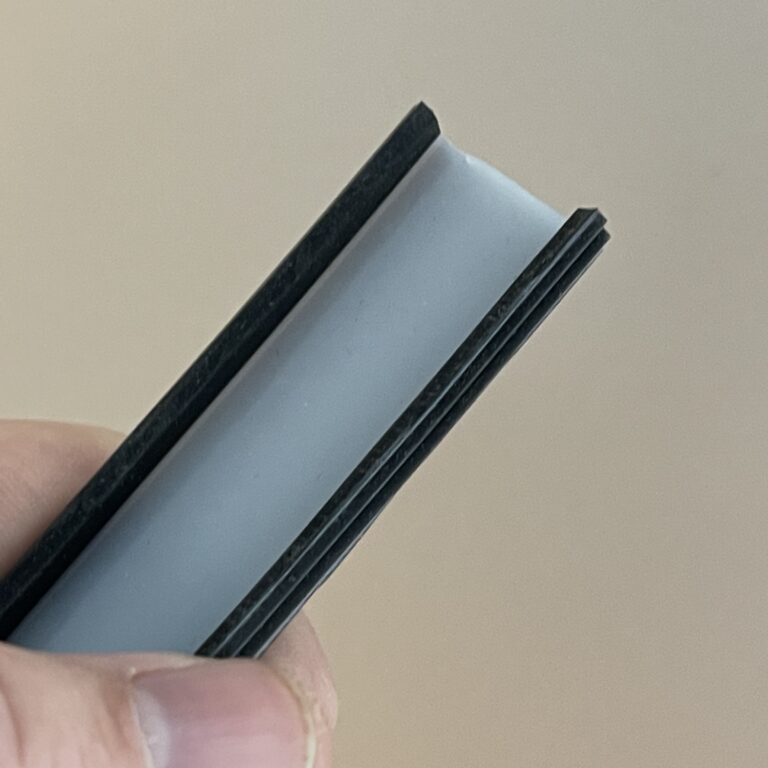
While grayish black in appearance, when the lights are switched on, they will be perfectly visible, but when off, they will be completely hidden.
The three sided diffuser is wider than the opening space (almost as wide as the entire track), but by squeezing it, it can be inserted through the hole and popped into place right over the top of the LED strips. When the diffuser expands back within the channel, the legs hold it away from LED and flush against the inner wall of the channel, replacing the opening in the channel with a “tinted window”.
Squeeze Diffuser to Install in Channel
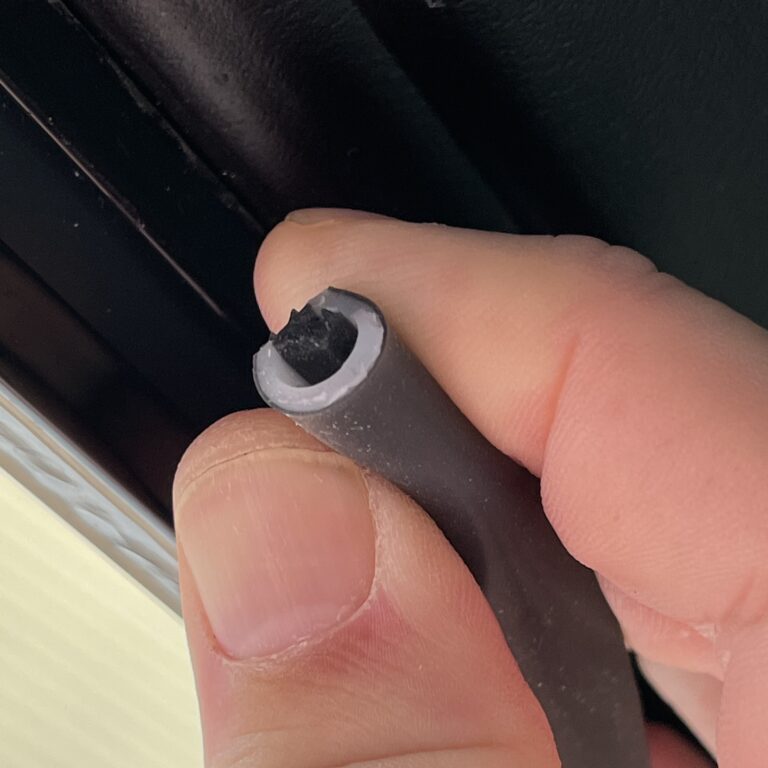
We use a hard but not sharp tool (like a vehicle trim removal tool) to help insert the diffuser along the track without piercing or damaging it. The material is easily cut to lengths to fit as needed. We cut it at each new bolt with semi-circle cuts to make it butt up against each bolt head along the way. Same on the other side of a bolt but the semi-circle cut is reversed and then continue on. When complete, every place that the LED strip was visible, has been covered with diffuser lens.
Diffuser Lens Installed in Channel Concealing LEDs
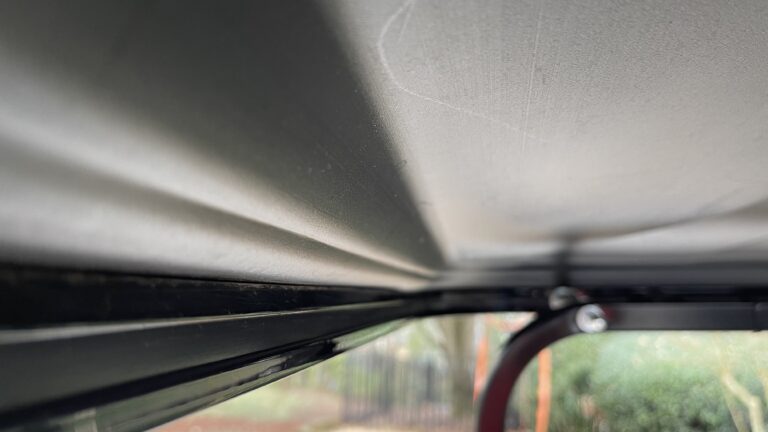
The lights are now imperceptible when off, but appear as if by magic when turned on. Mission accomplished. Check out the clip immediately below showing how the LEDs are completely hidden even in direct sunlight until they’re switched on.
Now You See Me... Now You Don't
And here is a final video showing the roof lights and diffusers installed and operating, grouped with some of our other Signature lights.
We hope this can be a helpful resource for anyone contemplating installing roof lights and uncertain how best to do it. It’s certainly not an exhaustive description of all the ways it can be done. It’s intended only to give some ideas and a basic jumping off intro. As always if you’re uncertain on wiring, consult a professional installer. And if you’re looking for an installer and can’t find one, feel free to give us a call. We have over 240 active installers all over the U.S. currently in our network and growing.




